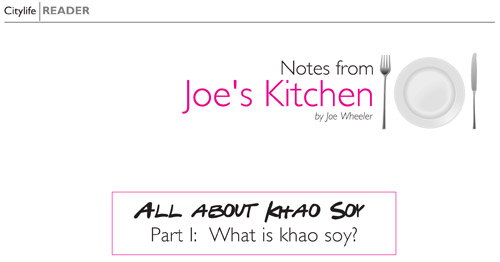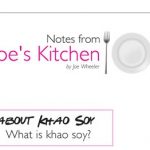
People seem to enjoy proselytising for pasta and noodles – everyone has a favourite. I know of two Japanese noodle movies and one Italian pasta movie. The plots usually involve a search for noodle/pasta perfection. This month, I begin a search for the best khao soy, Chiang Mai’s ubiquitous noodle dish.
Khao soy is a delicious curry soup. However, to call khao soy a curry soup is like describing a Cuban cigar as a smoke. It is the dish that is most strongly associated with Chiang Mai (it even merited a column in the Wall Street Journal recently.) Properly prepared, it is a bit of gastronomic heaven and satisfies all of the senses. The variety of colours in the dish makes it immediately appealing. The aroma alerts the taste buds to impending goodness. The combination of soft and crisp noodles, the silky liquid and the various condiments create a complex, satisfying texture. Its layers of flavour keep the mouth entertained and the lasting aftertaste reminds you to have another spoonful.
Khao soy translates as ‘cut’ or ‘chopped rice.’ Since there is no rice in the Chiang Mai version, where did the name come from? The answer lies in its origins. There are two theories. The majority opinion holds that khao soy originated among the Yunnan people in southern China. It was brought south when they were forced to emigrate from China. Some trace the dish further back to the Mongols under Genghis Khan. When the Yunnan came south, they settled in Burma and Laos, and eventually, in Chiang Mai. There are dishes similar to khao soy in both of these countries. In fact, the Shan people have a similar dish with the same name. These earlier versions used noodles made from a block of gelatinous rice flour rather than the noodles used today. They cut noodles from this block of rice, hence the name.
The minority opinion hypothesises that khao soy has a Malaysian origin. They say that the Chiang Mai dish is a local adaptation of curry laksa and that it was brought to Chiang Mai by people forced to emigrate from Malaysia for political reasons. There were certainly Malaysians from the Macassar region living in Ayutthaya in the late 17th century and there is no reason to doubt that some also settled in Chiang Mai. As they say in Thailand, the theory of choice is ‘up to you.’ In either case, the result for Chiang Mai is a vibrant, delicious bowl of goodness.
Despite its long history, the current version of khao soy, which includes coconut milk, is probably less than 60 years old. Prior to this time, coconuts were not widely available. The Chiang Mai area is not coconut palm friendly. Most were imported from Sukothai and places south. Once coconut milk became widely available, some enterprising stall owner added this ingredient and Chiang Mai khao soy was born.
To cook khao soy from scratch is an involved process. If you would like to give it a try, check out this site: www.thaifoodmaster.com/origin/northern_thai/2031. However, aside from personal satisfaction, there are so many good khao soy restaurants in Chiang Mai, there’s no reason to dirty up the kitchen. Next month I will give you my take on some of the better khao soy venues. Beyond the usual suspects (Khao Soy Islam, Khao Soy Prince, Khao Soy Lamduan Faham, and Suthasinee), I plan to check several others recom- mended by western friends who have good palates. Please help with recommendations.
The Great Citylife Khao Soi Search
We are looking for the best khao soi in Chiang Mai. Please send me your nominations, along with detailed directions to the restaurant: Joe@chiangmaicitylife.com.
